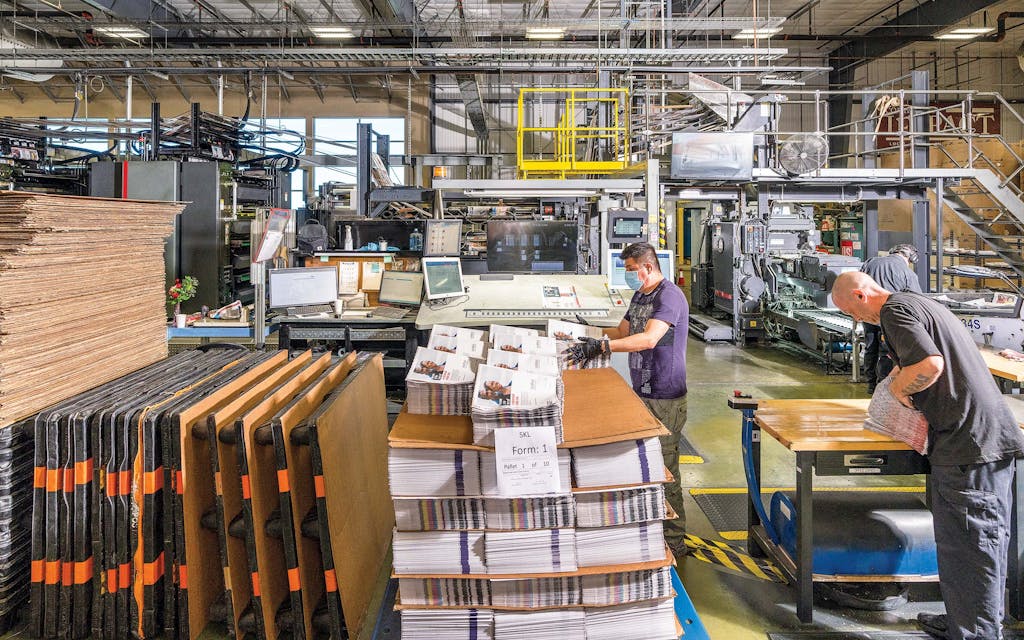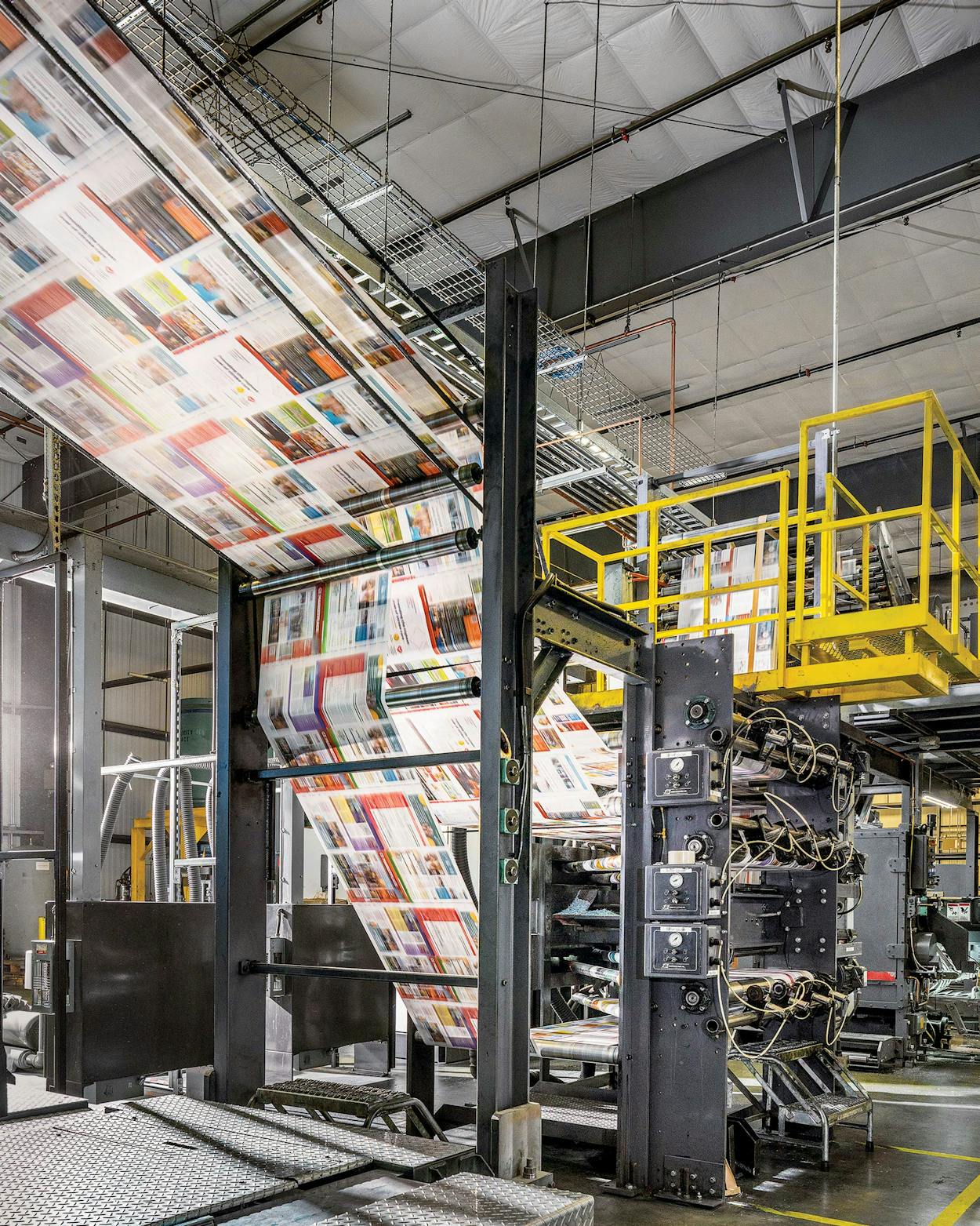Joe Warner manned the office’s patio grill on a drizzly morning in November, flipping burgers for the sixteen new employees who’d soon break for lunch after their first few hours of corporate orientation. A managing editor for Community Impact, a chain of local newspapers headquartered in Pflugerville, outside Austin, Warner, with his fellow editors, was about to receive an infusion of talent for a team of about sixty journalists who cover several dozen towns and neighborhoods in and around Texas’s four largest cities.
In defiance of almost every trend in print media in recent decades, Community Impact is expanding. Once a month, in fact, Warner, a 34-year newspaper veteran, fires up the grill for a new batch of “Impacters.” This time around, thirteen were hired to work on the editorial side of the business—reporting stories, designing infographics, or producing digital content such as email newsletters. Half of them were filling newly created positions.
Community Impact, which launched in 2005 as a single monthly paper covering the far-northern Austin suburbs of Round Rock and Pflugerville, now produces some 36 print editions around the state. Over the same period, local newspapers throughout the country have been closing at a rate of about two per week. Between 2005 and 2022, about 2,500 shut down in the U.S. (including 211 in Texas), according to a study from Northwestern University’s Medill School of Journalism.
Many of those that didn’t go out of business instead gutted their staffs and circulation, often at the hands of new private-equity ownership groups that specialize in pursuing short-term profits by slashing overhead rather than investing for growth. The Medill study reported that from 2006 to 2021, total newspaper employment in the U.S. plunged 70 percent. Texas lost more newspaper jobs per capita than every state but New Jersey. The newsroom staff at the Austin American-Statesman, to take just one example, has reportedly dropped from about ninety to roughly fifty since the paper was bought by GateHouse Media (which later merged with Gannett) in 2018.

Meanwhile, Community Impact has become a mainstay in the information diets of Texans who live in the areas it covers. The City of Round Rock conducts a wide-ranging survey about residents’ quality of life every two years. In 2022 the local Community Impact edition was far and away the top source of news and information about the city, listed by 77 percent of respondents. The Austin American-Statesman and the Round Rock Leader clocked in at numbers ten and eleven on the list, mentioned by only about 15 percent each. Surveys have shown similar results in other cities, including Buda, Georgetown, and Pflugerville.
John Garrett, Community Impact’s 47-year-old CEO, founded the company with his wife, Jennifer. He fits the mold of neither ink-stained traditionalist nor digital-media bomb thrower. A former advertising director of the Austin Business Journal, he’s a churchgoing suburban family man who simply thought the big metro papers were failing to provide information vital to many communities—and he devised a business model to do something about it.
Garrett doesn’t pretend that he’s found the one true solution to the local news crisis. His papers publish only once a month, and his company’s digital journalism is still finding its footing. His reporters really cover only small business and local government, especially as it relates to education, health care, real estate, and transportation—and that leaves out a lot of what happens in these communities. Yet sitting in his office at the corporate complex, with a tidy beard and his initials monogrammed onto the cuffs of his dress shirt, Garrett exudes a quiet confidence that he’s building something important.
“Why can’t Community Impact be the most trusted news source in all of Texas?” he asks, without a trace of bluster—just earnest ambition. “We’re a lot further on our way than a lot of people realize.”
It all started with a highway. Back in 2005, the northern suburbs of Austin were a shadow of their current selves, and Garrett, living in Round Rock at the time, didn’t know what to make of the toll roads under construction that would eventually come to frame the area. He’d ask around, and none of his neighbors knew many details either. “We didn’t understand where exactly they were going or how much they were costing,” he remembers. “It was just natural curiosity, like wanting to know if there was going to be a Starbucks near our house”—or a highway interchange or a sprawling new subdivision.
At work, Garrett would find himself telling advertising clients that readers subscribed to the Austin Business Journal because they wanted intel that could help them make money. One day it clicked that he could create an analogous product for folks who wanted to know about development plans before, say, buying or selling a home, or know about school district changes before deciding where to pack their kids off for kindergarten.
At the time, the Round Rock Leader had relatively few subscribers in a community of roughly 80,000 residents. “The coverage was just Johnny kicking the winning field goal,” Garrett says. It’s a favorite line of his, but it underscores that many small community newspapers focus on what some call “refrigerator journalism”—articles and pictures that proud parents clip out and display to show off their kids’ accomplishments. There’s nothing wrong with that, but often the same organizations neglect to send anyone to city council meetings.
Garrett’s idea for Community Impact involved more than just a commitment to cover neighborhood news. He and Jennifer put together the first issue in the game room of their home with the help of his now retired eighth-grade journalism teacher, Cathy Kincaid. To gain an advantage over their competitors, they sent the paper through the U.S. mail to every household in their target area, for free. That meant to those 80,000 Round Rock residents plus roughly 36,000 in Pflugerville—about 60,000 copies in all. Such reach would be attractive to local advertisers, Garrett figured, because it was both comprehensive and geographically specific. If it was too niche for big-budget national and regional brands, that was fine by him; his model counted on lots of little ads from the mom-and-pop shops, the corner restaurants, the dental practices.

It turned out to be a prescient move. Facebook was still just for college kids when Garrett devised his model, and iPhones were but a rumor. But as social networks and smartphones reshaped the media universe in the following few years, precision targeting became the governing principle of the advertising world. Mass media used to haul in ad dollars with the promise of the largest possible audiences. But the open secret of that era was that nobody really knew which ads worked and which didn’t. The digital revolution changed that, and suddenly every advertiser expected to know exactly whom they were reaching—for local businesses, that meant reaching those who lived nearby.
Today the circulation of Community Impact editions ranges from 40,000 to 120,000. Garrett considers 60,000 the sweet spot, maximizing what the paper can charge for ads without pricing out smaller clients. As the company’s reach has expanded, one of its most important innovations has been ever-tighter targeting, where advertisers can pay to show up only in papers sent to a small subset of readers—down to the level of individual mail-carrier routes. In Round Rock, for instance, there are sixty possible iterations of the local Community Impact paper, each of which can have different ad inserts, stick-ons, and other customizations.
Amid all the media hand-wringing about digital disruption, Garrett says, “what no one really talks about is that geography is the number one priority for local advertising. So if you’re a business that’s trying to reach people who like Metallica, and you’re really trying to dig into the demographic and psychographic data on that, Facebook can help you. That’s not for us. But the majority of local businesses are looking for customers who live within a five- or ten-mile radius of the store—and we can compete with Facebook there.” The digital giants can target users geographically, of course, but Garrett argues that using that technology can be impersonal and expensive—at a Community Impact paper, a business owner can talk to a sales rep who lives in the area.
Yet no matter how precisely they can target potential customers or how neighborly the sales process feels, no advertisers are going to care if no one is reading the newspaper. The product itself—the stories and photos and infographics—has to be sufficiently high quality to attract eyeballs. To that end, Community Impact has also found a formula that’s working for it.

There’s a term for what becomes of a place when there are few or no reporters left: news desert. Texas is full of them, not just in remote small towns where you might expect but throughout the neighborhoods and suburbs that make up the biggest metro areas.
When big daily papers were at peak profitability in the eighties and nineties and had hundreds of reporters, a portion of them typically covered different geographic beats. A large part of their jobs involved attending routine community meetings—the local school board or planning commission, for instance. Many such meetings today go unattended by journalists, and research has shown that civic engagement tends to drop correspondingly, says Penelope Muse Abernathy, a former New York Times and Wall Street Journal executive who authored the Northwestern University study on newspaper closures. She cites correlations between news deserts and decreased voter participation, more government corruption, and even higher taxes. It makes sense: with nobody around watching, sweetheart contracts end up with cities overpaying for services, and information about important issues doesn’t make it to voters.
None of which is to suggest that Community Impact practices hard-nosed investigative journalism that takes aim at corrupt officials. A typical issue, sixty pages in the biggest areas, contains a roughly even mix of announcements about new shops and amenities, trend data about the real estate market, and a few brief updates about major city projects—plus a lengthy news-you-can-use report on one community issue, such as school accountability, public transportation changes, or an upcoming election. There’s very little sports or crime coverage (those subjects are better suited to dailies or digital), and it doesn’t publish op-eds. Last year the arrest of Kaitlin Armstrong in the killing of a professional cyclist in Austin made headlines around the world—but not in Community Impact. A sting operation exposed a sex-trafficking ring in Frisco and Southlake this January, but Community Impact didn’t mention it.
When 28-year-old Anna Lotz joined the company straight out of Cedarville University, in Ohio, she’d never traveled west of the Mississippi River, let alone to Texas. After starting as a reporter in 2016, she’s now the editor of two Community Impact papers in the northern exurbs of Houston—Tomball/Magnolia and Conroe/Montgomery—with a team of three reporters and a designer reporting to her. Each Community Impact region has a similarly lean staff. (The company is “an amazing place to jump in and learn,” Garrett says—an industry euphemism for hiring young, inexpensive journalists.)
Some efficiencies come from sharing citywide or statewide stories across multiple editions, but the vast majority of each issue’s content is specific to that area. Lotz’s team can even boast of some scoops, such as a recent report about the City of Magnolia implementing a development moratorium because its water infrastructure was maxed out. “For a little city of twenty-three hundred residents that’s been waiting for years for H-E-B to come amid all the other new development . . . this has huge ramifications for the economy,” she says. Other outlets have since covered the story, but Community Impact was out front. Lotz credits a tenet of Beat Reporting 101: her reporters showing up again and again at meetings with local leaders. “You’re able to build relationships, and a lot of times it’s the little conversations that happen before a meeting or during a break that are more candid and end up generating the best stories.”
Although the model works in the suburbs of major cities, that doesn’t mean it works everywhere. Abernathy notes that Texas has more counties without a dedicated newspaper than any other state (partly because it has more counties, period—254—but still). And the Community Impact model simply isn’t suited for small towns in sparsely populated areas. There aren’t enough thriving local businesses in those areas to buy enough ads to support a local edition. Garrett envisions testing papers in midsize cities such as College Station or Waco, but so far the company hasn’t; there’s still too much room to grow in and around the biggest cities.
But there are also significant limitations to the company’s expansion in the major metros, Abernathy points out. Community Impact thrives in fast-growing areas—the booming suburbs, the shiny new heart of Austin—but it doesn’t publish editions focused on, say, southern Dallas or the east side of Houston. “We are a nation divided journalistically between those who have a lot and those who don’t,” Abernathy says. “If you’re a publication relying on advertisers, you go where the customers are. You go to these robust economic centers, not to the marginal, low-income communities”—even if those places could especially use a few reporters showing up and shedding light.


One day in March 2020, Garrett and a handful of his executives were on a plane to Atlanta to celebrate a new Community Impact paper there when they found themselves debating whether to wear face masks at the launch party, or whether they should be gathering at all.
Atlanta was the company’s third market outside of Texas, after expansions to Phoenix and Nashville in 2018 and 2019, respectively. The Garretts had built their Pflugerville headquarters in 2013 and a printing plant next door in 2016. Revenue had topped $30 million in 2019, and John Garrett had a five-year plan to roughly double that figure while expanding to ninety areas in the four cities—and then beyond. He called it the Drive to 2025.
But within weeks of that flight to Atlanta, COVID-19 locked down his advertisers’ shops and restaurants. Sixty percent of Community Impact’s revenue evaporated overnight. By August of that year, it had laid off about twenty workers and shut down the Atlanta paper. To stretch the remaining staff, some editions were consolidated.
Today the company is back to fast growth—if not anywhere near where the Drive to 2025 would have put it. Its Texas revenue for 2022 came in at $30 million, just shy of its 2019 high mark and up 20 percent from 2021. The chain is adding journalists to the roster and keeping Joe Warner busy flipping burgers on orientation days. But this past summer the Garretts decided to swallow their pride and pull out of Nashville and Phoenix. Since the onset of the pandemic, the additional expenses and hassles of trucking papers from Pflugerville to U.S. Postal Service distribution centers in those markets just hadn’t proved worth it.
Luckily for Garrett, Texas is big. Even if Community Impact can’t find a way to make the numbers work in midsize cities and underserved communities in the big metros, it has ample room to grow. The company has barely scratched the surface of San Antonio or Fort Worth, and there remain untapped swaths of the Dallas and Houston areas that could support papers. Then there’s the internet. The papers’ news reporters file stories multiple times a week online, and Community Impact now has more than 100,000 subscribers to its family of hyperlocal email newsletters.
Texas is also obsessed with itself and its biggest homegrown brands, and Garrett’s ambition is to build one of those—the H-E-B or Whataburger of local news. His and Jennifer’s oldest daughter is studying journalism at UT-Austin, and Garrett can’t resist dreaming about her, or one of her sisters, taking over Community Impact one day. “Maybe,” he says, “our story is just beginning.”
This article originally appeared in the April 2023 issue of Texas Monthly with the headline “An Oasis in the News Desert.” Subscribe today.
- More About:
- Business
- Pflugerville









